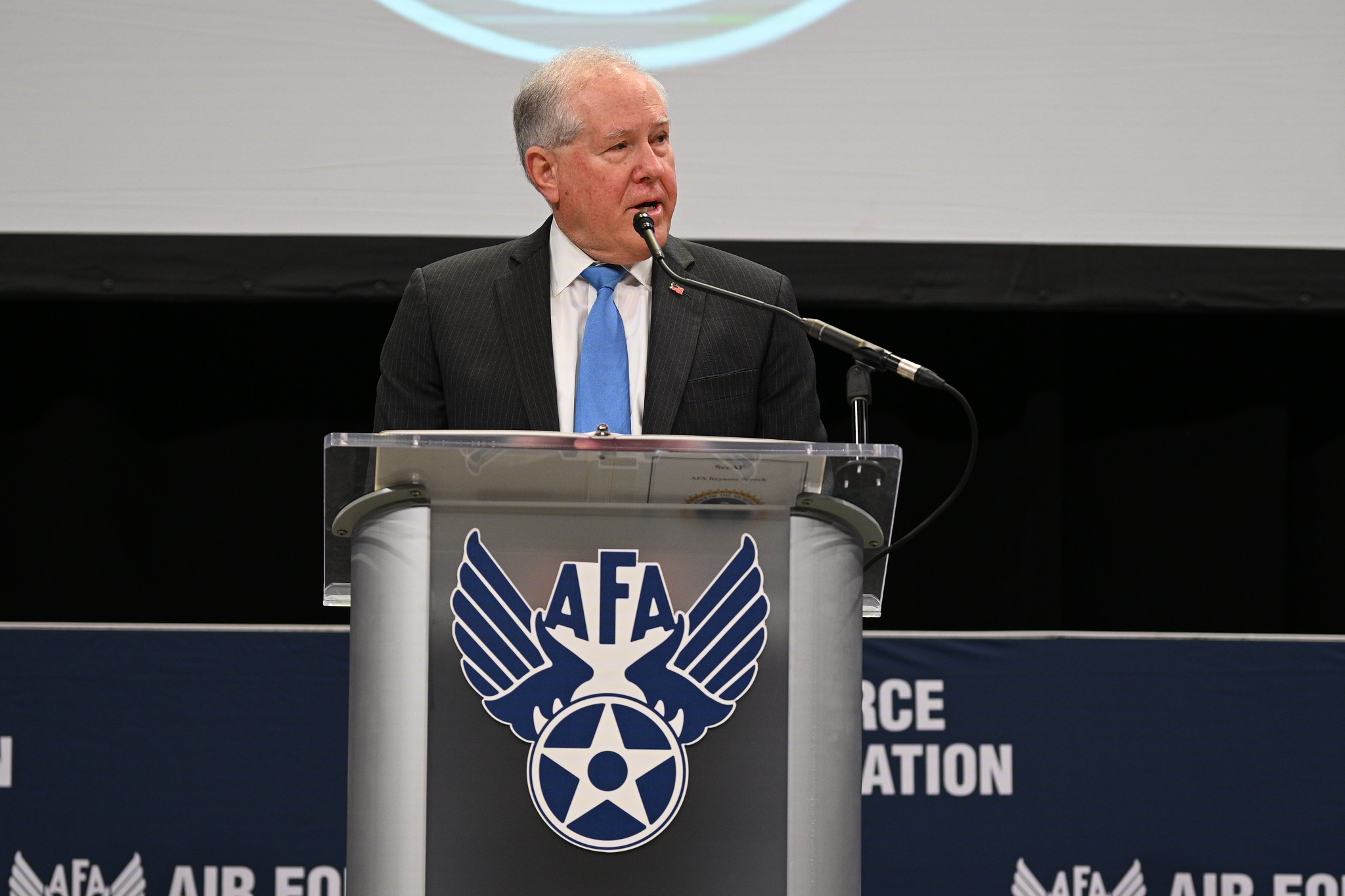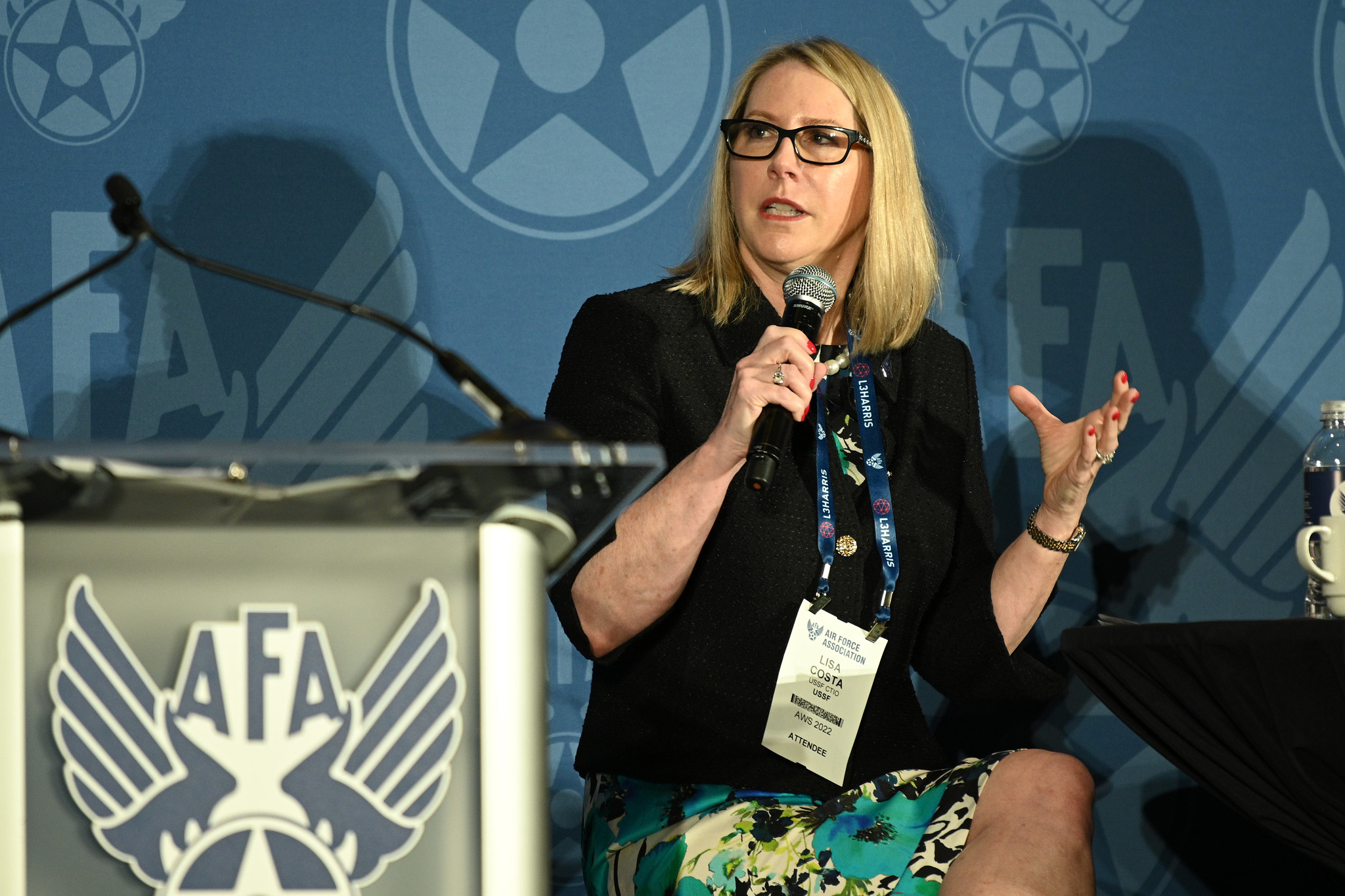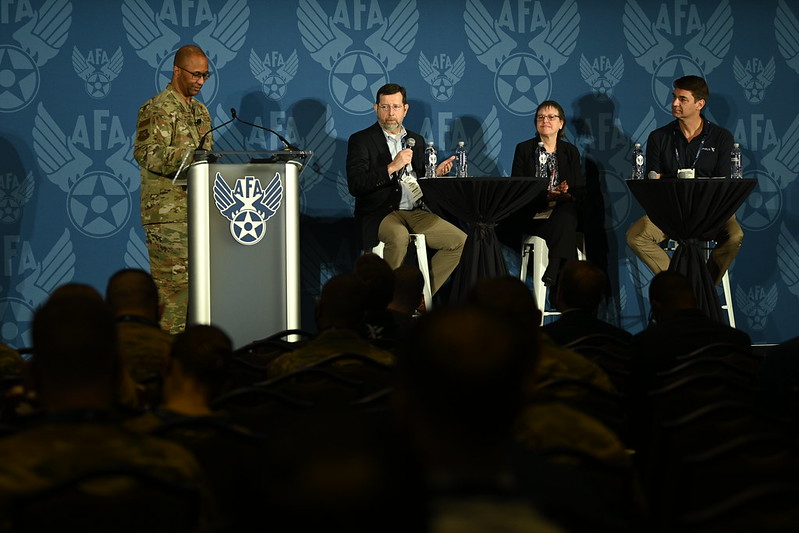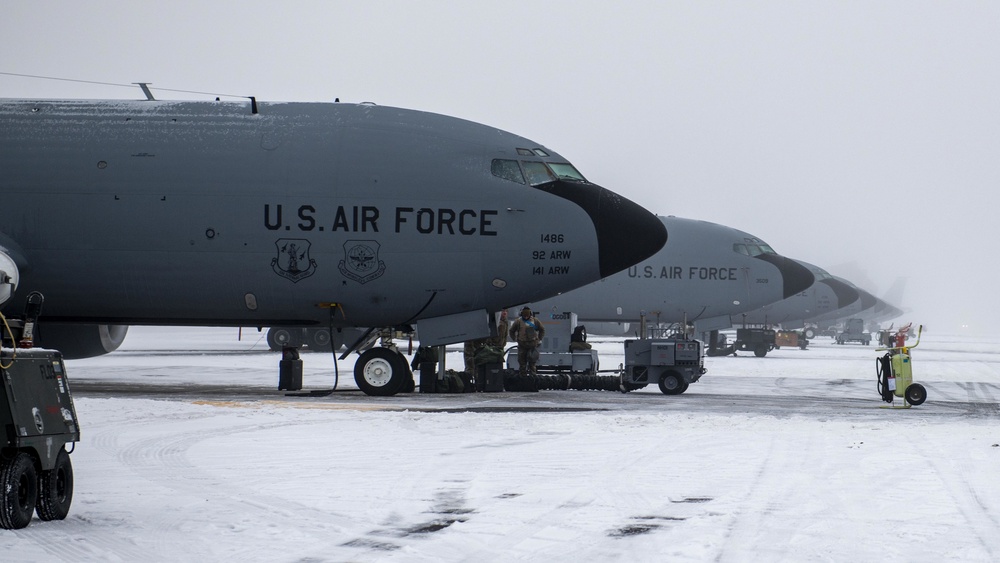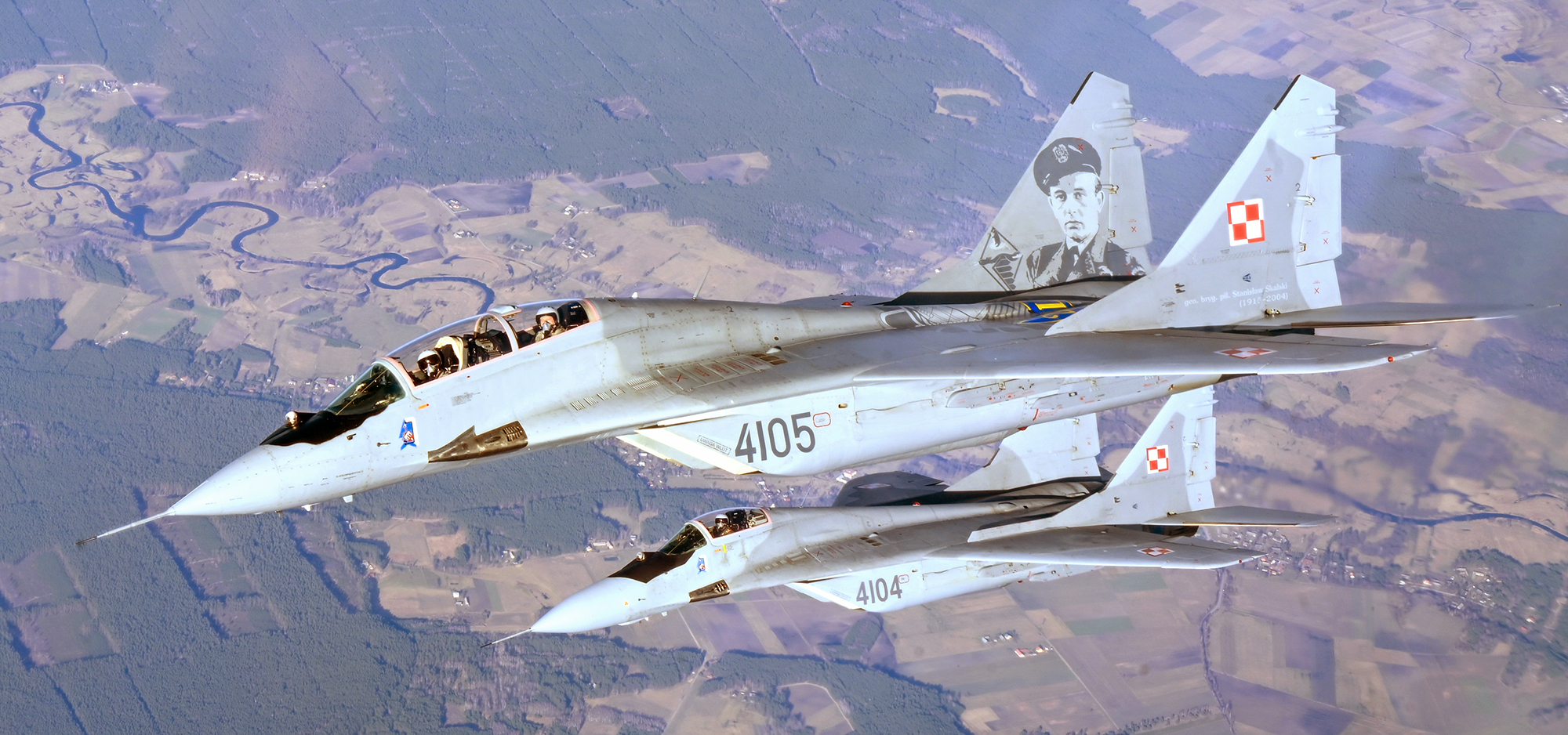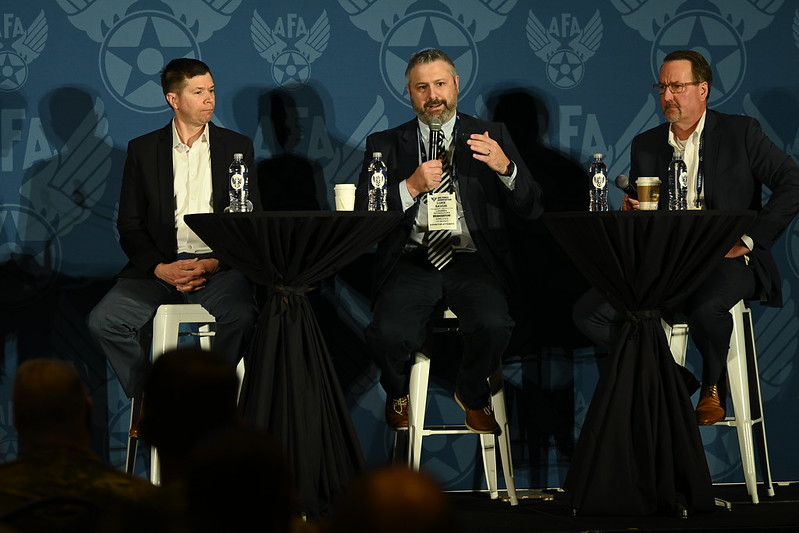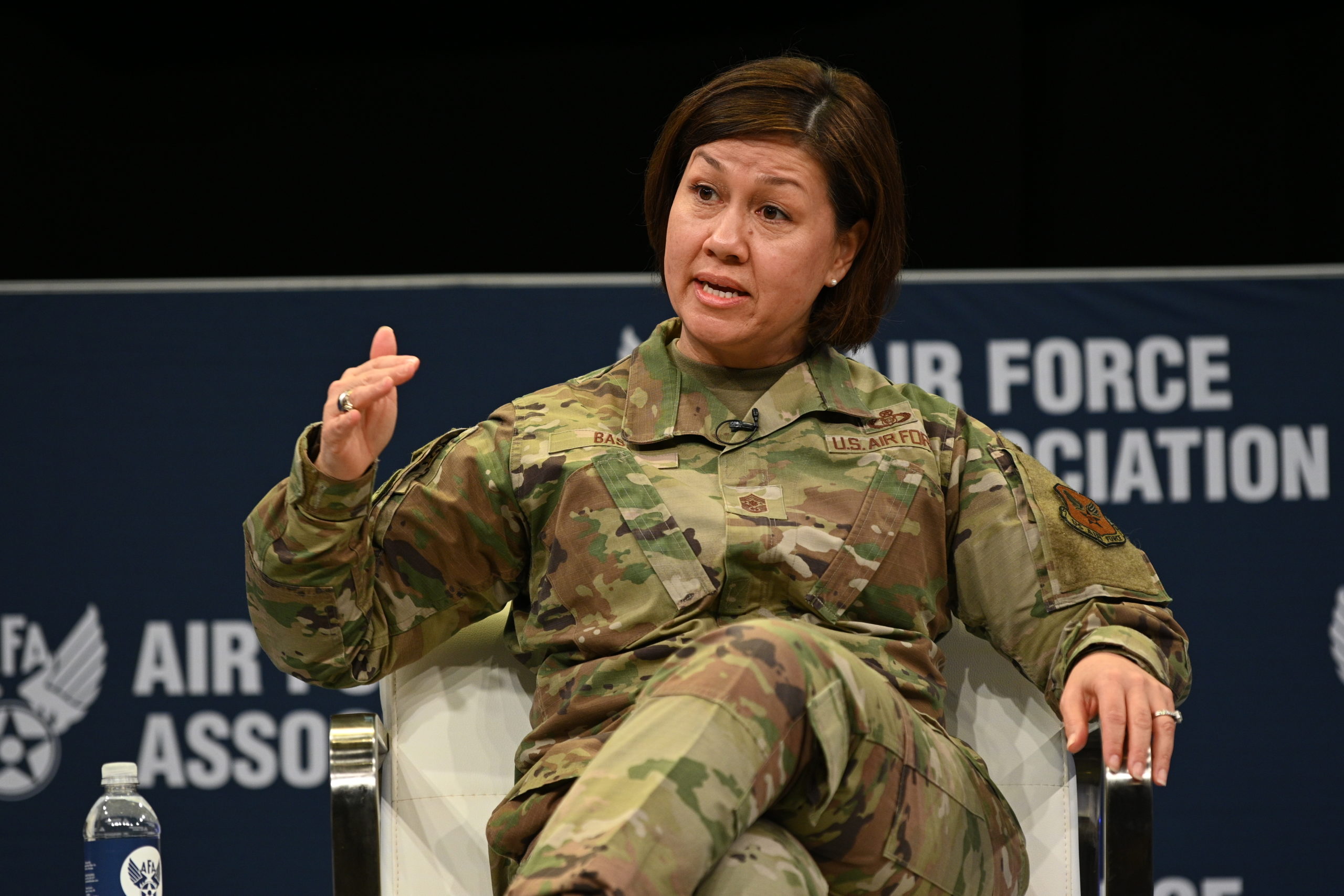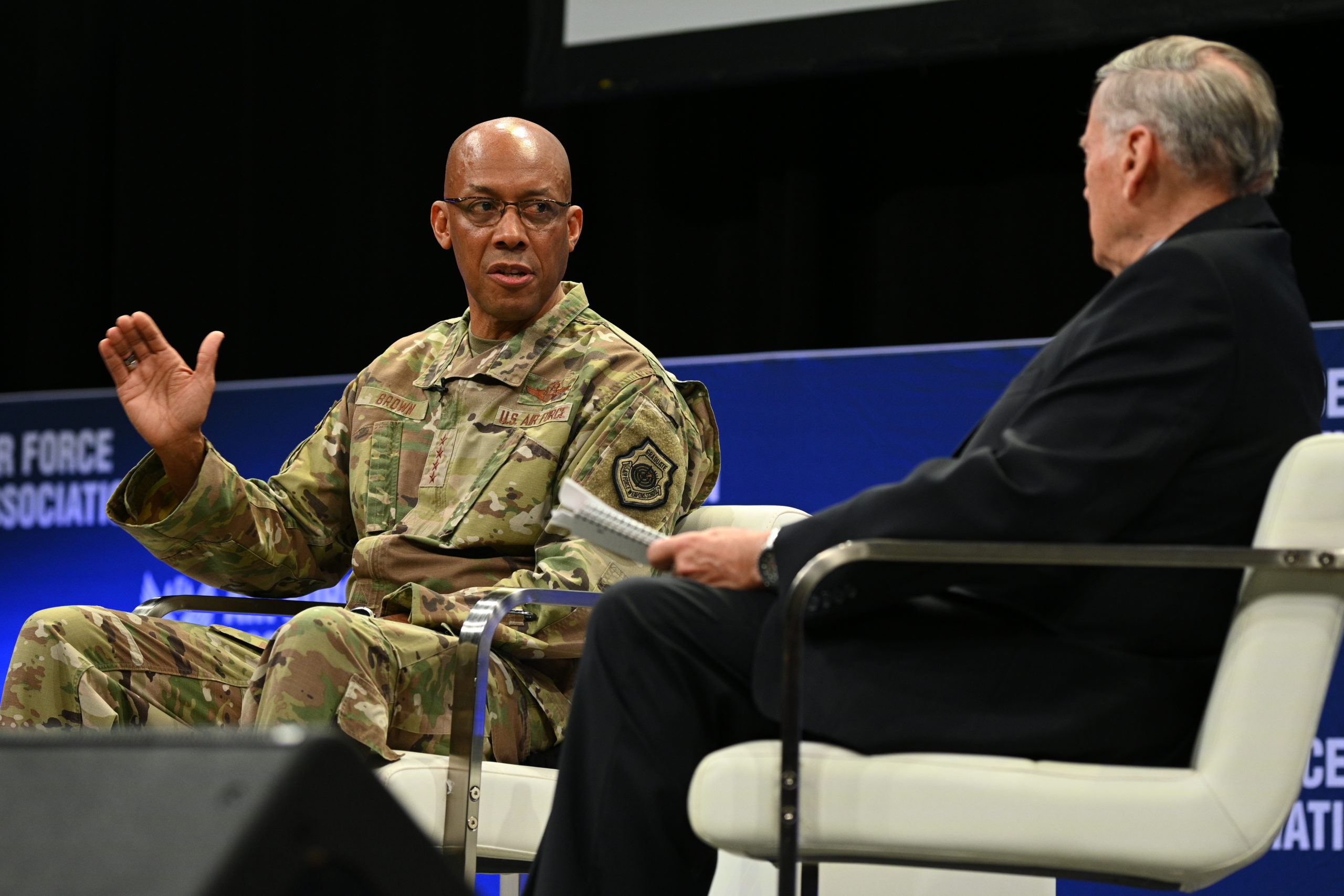Watch the video or read the transcript of Air Force Secretary Frank Kendall’s March 3, 2022, keynote address during the AFA Warfare Symposium: “One Team, One Fight.” This transcript is made possible through the sponsorship of JobsOhio.
Good morning. I’d like to first thank AFA for their patience and their cooperation as we worked through the process of having another major AFA conference during the COVID pandemic. Last fall we were hopeful that COVID was receding as people became vaccinated. Unfortunately, the Omicron variant had other plans, and too many Americans, for whatever reasons, made decisions not to be vaccinated. I’m hopeful once again that we’re on a good trajectory, and I appreciate the vast majority of Airmen, Guardians, and DAF civilians who have become fully vaccinated. Yesterday we stopped wearing masks in the Pentagon. It was truly great to see all those smiling faces; in fact it was great just to see those faces, but they were smiling. The DC area met the CDC’s new low-risk criteria; unfortunately Orlando does not. We’re definitely making progress – at least for now. Let’s keep it up. I don’t want to sound like a nag up here. I emphasize what the chief just said a moment ago. We do not want to be the super source or a super-spreader for a new variant that sets us all the way back so let’s please follow the rules while we’re here. I’d really appreciate that; all our Airmen and Guardians here appreciate that as well.
I want to especially highlight the resiliency of our Airmen and Guardians and their families. The last two years have upended everything that we might consider our normal routines, across the board. These men and women, from every imaginable background, have never stopped working to ensure that the United States Air Force and Space Force remain the best the world has ever seen, and their families have borne this burden right along with them. I also appreciate all that industry has done to continue supporting our nation during this crisis. My hat’s off to every one of you.
I’ve been part of our “one team” for over six months now, and what I’d like to do this morning is to give you some feedback about what I think I’ve learned so far about our Department, what I’ve tried to accomplish in my first few months, and where I think we need to go. Before I do all that though, I’d like to say a few words about current events and our historical context.
Somewhere during my education, I recall being instructed that it’s dangerous to draw major conclusions from contemporary historical events. Understanding and interpreting the broad, lasting impact of highly-disruptive events requires some distance in time, and a clear-eyed, objective perspective that is simply impossible in the moment. I think that observation was wise, but here we are. The threat of a major land war in Europe was something that until a few days ago most of us believed was extremely remote. So much for that.
Two Fridays ago I spent the day at CYBERCOM. As I was leaving, I mentioned to General Nakasone that based on what I’d seen that day, most of the world was about to have a major emotional event; something that would shock people into a new understanding of reality, something which has now unfortunately come to pass. A few weeks ago, well before the invasion of Ukraine, I told those present at the weekly Department of the Air Force staff meeting that they should put one of those little yellow sticky notes up on their workstation to remind themselves that great power conflicts could happen, and could do so at any time.
I was trying to create a stronger sense of urgency about the importance of our work. I don’t think there is much doubt about the possibility of major power acts of aggression at this point. If war between major powers does happen, it will most likely be the result of a miscalculation by an authoritarian head of state.
In my view President Putin made a very, very, serious miscalculation. He severely underestimated the global reaction the invasion of Ukraine would provoke, he severely underestimated the will and courage of the Ukrainian people, and he overestimated the capability of his own military.
Perhaps most of all, he severely underestimated the reaction from both the United States and from our friends and allies. A few weeks ago, I had the opportunity to have dinner at the home of the Ambassador to the United States from Finland. His comment to me was that the actions the Biden Administration was taking to prepare and unite the free world to counter Russia might not stop Putin from invading—he’s likely to have already made the decision to do so—but, they are preparing the world for like-minded nations to work together if he does invade. As I often say: One team, one fight.
Where this will lead, I honestly don’t know, but if President Putin thought he could divide NATO, divide Europe, and even divide the United States, he was wrong. Now it’s up to all of us to ensure that something like this does not happen again. Our role, the role of the Department of the Air Force, is clear: to provide the Air and Space Forces that will deter aggression, and if necessary, defeat it. As my former boss Secretary Leon Panetta said in every speech I ever heard him give, there is no more sacred obligation than the duty to protect our nation and our values.
How will we meet this obligation? The Biden Administration is about to release the National Security Strategy and National Defense Strategy. I don’t want to get ahead of that process, but you can be confident that despite current events the pacing challenge remains China.
You can also be confident that alliances and partnerships will be emphasized under the “integrated deterrence” rubric. Russia and other threats will not be discounted, but China, with both regional and global ambitions, the resources to pursue them, and a repressive authoritarian system of government, will be our greatest strategic national security challenge. Some of you will recall my three priorities from last September when I spoke at that AFA conference – China, China, China.
Since then I’ve had several months on the job. What have I learned? Firstly, I’ve gotten to meet a lot of Airmen and Guardians. Nothing is more inspiring to me than to have informal conversations with the men and women who wear the Air or Space Force uniform. The dedication, commitment, professionalism, and passion these people bring to their service and to the nation is simply awesome. Thank you, all.
As I’ve traveled to places like Alaska, Montana, North Dakota, and Thule Greenland, the positive attitudes, drive, and commitment I’ve seen from our men and women serving far from home and sometimes in challenging circumstances is just exceptional. I am going to talk to my staff about some warmer travel options, however. Diego Garcia, Niger, and Djibouti are on the list for this year and I’m telling my staff that we’ll average out to a very moderate temperature.
My remarks today are about warfighting and operational capability, the subject of this conference, so I won’t be focusing on people today, but our Airmen and Guardians are the heart and soul of who we are, what we stand for, and what we are sworn to protect. I have enormous respect for our Airmen and Guardians. They are always foremost in my mind, and I know I can say the same on behalf of the entire Department of the Air Force leadership team.
But I’ve also learned about the problems our institution faces. We’re stretched thin as we meet Combatant Commanders’ needs around the globe. We have an aging and costly-to-maintain capital structure with average aircraft ages of approximately 30 years and operational availability rates that are lower than we desire.
While I applaud the assistance the Congress has provided this year, we’re still limited in our ability to shift resources away from legacy platforms that we need to retire to free up funds for modernization.
We’re not flying and training as much as we would like to be, sacrificing in part a significant historical advantage of superior flying experience for our pilots and our aircrews. We’re carrying the costs of a roughly 20 percent excess capacity of real estate. We have a significant number of programs in the Air Force that are not fully-funded beyond the budget year. We have a Space Force that inherited a set of systems designed for an era when we could operate in space with impunity.
Moreover, our entire military was designed for an era in which our potential adversaries did not possess space systems of their own that actively threaten our terrestrial joint forces. We’ve only begun to define, and have not yet fully resourced, the space systems that we will need to secure the nation.
Overall, we do start more programs than we can afford, and we don’t prioritize the most promising ones early so that we can ensure they cross the value of death to production and fielding. As General Brown has noted in his recent orders, we still have too much bureaucracy.
Finally, we know that despite the progress we’ve made, we have more work to do to ensure every Airman and Guardian has the opportunity to reach their full potential and to serve in an environment where they will always be treated with respect.
The Department of the Air Force’s senior leadership team, myself and the Under Secretary, the Service Chiefs, their Vices, and our Senior Enlisted Leaders, are all focused on addressing these issues. While I’m involved in getting after every one of them, my highest personal goal as Secretary has been to instill a sense of urgency about our efforts to modernize and to ensure that we improve our operational posture relative to our pacing challenge; China, China, China. The most important thing we owe our Airmen and Guardians are the resources they need, and the systems and equipment they need, to perform their missions.
To achieve this goal, I’ve commissioned work on seven operational imperatives. These imperatives are just that; if we don’t get them right, we will have unacceptable operational risk. For those here from industry please pay attention; this is what the Department of the Air Force will be investing in and this is where we need your expertise, intellectual capacity, and creativity.
Before I walk you through them, let me give you a little historical context to set the stage. I’ve been around a few decades and I’ve always loved history. Keep in mind that China started its efforts to defeat U.S. power projection forces about 30 years ago, after the First Gulf War. What does that mean – 30 years? Let’s take a quick look at four 30-year-long periods in modern history and the history of warfare.
In 1901, there was no significant military air arm, there was no military air arm. The Wright Brothers were refining the design of the 1903 Wright Flyer, but at this time there had never been a manned, powered, heavier-than-air aircraft flight.
Thirty years later, in 1931, we had fought World War I and airpower, machine guns, tanks and radios had become a major element of modern militaries. By 1931 Billy Mitchell had demonstrated the obsolescence of the battleship, even if some were still not convinced. By 1931 there was an Army Air Corps with about 17 hundred aircraft.
Another 30 years later in 1961 we had fought World War II and the Korean War, demonstrated the criticality of airpower to tactical and strategic operational success, transitioned from propellers to the jet engine and from guns to air-to-air missiles. We had introduced intercontinental bombers, ICBMs, satellites, and of course nuclear weapons.
By 1991, the beginning of the 30 years in which China has been investing in ways to defeat U.S. power projection, we had fought the war in Vietnam, the Soviet Union had collapsed, and we demonstrated unprecedented conventional warfare dominance in the First Gulf War. The entire world had begun its reliance on GPS. Airborne surveillance systems—AWACS and prototype JSTARS—provided air and ground situation awareness and C3 battle management. The first stealth fighter, the F-117, was used in combat. Thirty years ago the B-2 had flown and the F-22 was in development.
The final 30 years take us to last year, 2021. In this period space was militarized to provide targeting support to long-range ground, sea, and air-based missiles; ground-based anti-satellite weapons were fielded and a range of counter-space weapons entered development to threaten satellites in all orbits. Highly accurate land and maritime attack Medium Range Ballistic Missiles and advanced land attack cruise missiles were fielded.
Beyond visual range air-to-air missiles were fielded, and a variety of hypersonic weapons, including intercontinental-range systems were tested or fielded. Military services devoted to long-range precision rocket forces and strategic support forces for space and cyber warfare were created, transforming military structures. Unlike the 30 year periods that I discussed before this one, these items on the list I just gave all occurred in China.
The point is that for the last 120 years, technology and warfare have changed dramatically in each 30 year increment. During the last 30 years, the US has not stood still, but we have not moved fast enough. We must accelerate change or, as General Brown noted, we will in fact lose.
A few months ago, the senior Department of the Air Force leadership team agreed to focus on a list of seven operational priorities, imperatives to help guide our investment decisions. These imperatives are all things we must accomplish in order to provide forces that can deter or defeat conventional military aggression by a peer or near-peer competitor. The two stressing cases we’ll analyze are a possible invasion of Taiwan and land assault on a NATO member. We have very visible evidence now that at least one of those is quite possible; so is the other one. Both are characterized by high operational tempos with large numbers of combatants on each side.
These are not the types of problems the Department of the Air Force has been focused on since the Cold War ended and especially not since 9/11. But as current events show, they are the types of problems we must be organized, equipped, and ready for. Not some time in the future, but now.
Fortunately we’re not starting from zero, but in each case we do need to improve our capability with a sense of urgency. I’m not at liberty to discuss the FY23 budget yet, but you’ll see alignment between the Department of the Air Force’s budget and the National Security and Defense Strategies on one hand, and these imperatives on the other. That said, there is still a great deal of work to be done in finalizing the best long-term modernization program for each of these imperatives.
Some of that work will, by necessity, have to inform our FY24 submission next year. The way we’ve organized the work is to put a team of operational and technical or acquisition experts in leadership roles for each of the seven imperatives. The overall effort is led from the operational perspective by Lt Gen Hinote for the Air Force and Lt Gen Liquori for the Space Force. Darlene Costello is the overall lead for acquisition and technology.
None of the operational imperatives exists in isolation. Space considerations transcend each and every one of them, and many are tightly coupled. For that reason, we’ve brought on board Dr. Tim Grayson, who has joined the Department of the Air Force as a highly qualified expert — small letters — responsibility for overseeing and coordinating the work on the seven imperatives.
Analysis efforts across the imperatives are being conducted by the Department of the Air Force Studies and Analysis organization led by Rowayne Schatz and the Space Warfare Analysis Center led by Andrew Cox. This will not just be an internal Department of the Air Force effort. For the industry, laboratory, and FFRDC people here, we need and welcome your help in addressing each of these imperatives successfully, and we’re actively soliciting your inputs.
The first imperative is Defining Resilient and Effective Space Order of Battle. The U.S. and its allies depend on space for a range of military services; communications, intelligence, targeting, navigation, and missile warning included. Our potential adversaries have fielded their own versions of these services and are also fielding a variety of ways to attack U.S. systems.
The simple fact is that the U.S. cannot project power successfully unless our space-based services are resilient enough to endure while under attack. Equally true, our terrestrial forces, Joint and Combined, cannot survive and perform their missions if our adversary’s space-based operational support systems, especially targeting systems, are allowed to operate with impunity.
This imperative will build on the excellent work already completed by Gen Raymond and his team, including that conducted by the Space Warfare Analysis Center, the Space Development Agency, and others. We’re also working closely with the Intelligence Community, especially the National Reconnaissance Office led by Chris Scolese.
As a critical input to this effort, the Vice Chief of Space Operations, Gen D.T. Thompson, is leading the effort with the other Services to define the totality of Joint operational requirements for support from space. We’re also grateful for the pioneering work done by General John Hyten, who recently retired, when he defined the vision for future military space. One team, one fight.
Of all the imperatives, this is perhaps the broadest and the one with the most potential impact.
The second imperative is Achieving Operationally-Optimized Advanced Battle Management Systems (or ABMS). This imperative is the Department of the Air Force component of Joint All Domain Command and Control. It is intended to better define and focus our efforts to improve how we collect, analyze, and share information and make operational decisions more effectively than our potential adversaries.
Our existing battle management platforms such as JSTARS and AWACS are aging and difficult to defend against modern threats. Our C3 battle management centers, Air Operations Centers especially, are in great need of modernization and are also vulnerable to attack. The theory of ABMS, and more broadly JADC2, has been that by using modern networking and communications capabilities in tandem with artificial intelligence for battle management and data collection from numerous sources, we can effectively process information to support superior operational decision-making, substantially improving the performance of our forces.
That’s a reasonable working hypothesis, but we can’t invest in everything and we shouldn’t invest in improvements that don’t have clear operational benefit. We must be more focused on specific improvements with measurable value and operational impact.
Also, as I’ve learned more about our current “legacy” C3 battle management systems, it’s also become apparent to me that the Department of the Air Force needs more than just ABMS appliques that add specific capability and connectivity, and more automated decision making. We also need a program to modernize C3 battle management more generally. This imperative will finish the job of defining that program.
The next imperative is Achieving Air and Ground Moving Target Identification at Scale. The scenarios of concern present target-rich environments in which densely spaced, many-on-many engagements, in a compressed timeframe are the norm. ABMS and JADC2 won’t be of any value without efficient, timely target acquisition. The targets of interest are air, ground and maritime mobile targets associated with an act of violent aggression, such as the one we just saw in Europe or an invasion of Taiwan.
This imperative is about identifying, tracking, and enabling the engagement of numerous targets—such as mobile missile launchers, ships, aircraft, etc—nearly simultaneously. The scenarios of interest are likely to be more like D-Day and decided in a few hours, rather than the long term strategic bombing campaign carried out by the Eighth Air Force.
Currently, the Department of the Air Force uses aging and vulnerable legacy systems, JSTARS and AWACS principally, to provide Air and Ground Moving Target Indication radar-based “pictures” if you will of the battlefield or airspace, and targeting-quality tracks for handoff to other platforms and engagement systems. What enables our aforementioned ABMS investments to be successful starts with the ability to acquire targets using sensors and systems in a way that allows targeting data to be passed to an operator for engagement.
The efficiencies from ABMS and JADC2 come from the ability to see the battlefield and to then make smart decisions about which of those targets to engage and what weapons to employ. But for the scenarios of interest it all starts with those sensors. They must be both effective against the targets of interest and they must be survivable.
Ideally we’d prefer to do these functions from space, which should be more cost effective if adequate resiliency could be provided, but that isn’t the only possibility. And technical limitations, as well as the urgent need to replace some of our aging legacy systems, may limit near-term options for some of this functionality. This imperative will identify, analyze, and select for investment the most promising approaches to acquire and analyze AMTI and GMTI data. The Department of the Air Force is working closely with the intelligence community as we explore this trade-space.
The next imperative is Defining the Next Generation Air Dominance (or NGAD) System of Systems. On its current trajectory the tactical air force is not affordable. The crewed fighters we plan to acquire; F-35, F-15 EX, and the NGAD platform, are all too costly to fill-out our needed force structure as legacy aircraft retire. In effect the F-35 becomes the low end of our high-low mix.
NGAD must be more than just the next crewed fighter jet. It’s a program that will include a crewed platform teamed with much less expensive autonomous un-crewed combat aircraft, employing a distributed, tailorable mix of sensors, weapons, and other mission equipment operating as a team or formation.
The program that became the NGAD experimental technology demonstrator program started with a DARPA study that I commissioned several years ago that concluded we needed a system-of-systems approach for next generation, air-to-air combat. I believe this is a valid concept, even more so than seven years ago when the study was conducted.
This imperative envisions nominally one to five un-crewed combat aircraft controlled by a single, modern, crewed aircraft – principally the NGAD platform but also potentially the F-35. The idea is for the crewed aircraft to be essentially calling plays and employing the un-crewed combat aircraft as wingmen in tactically-optimized ways. Introducing these un-crewed autonomous and attritable aircraft to the tactical air dominance equation opens up a world of fascinating tactical opportunities.
The exact mix of crewed and un-crewed teaming, what is carried on those un-crewed aircraft individually, and what kinds of plays could be available for the operator to select, these are all being analyzed and defined as part of this imperative.
This imperative builds on work already done under programs like Skyborg in the Air Force, ACES at DARPA, and the Australian loyal wingman program, and others. The intent is to cross the valley of death and move forward with the fielding of the first instantiation of a program of record that integrates crewed and un-crewed platforms operationally. The assessment we have made is that the technology programs I have discussed—and others—have done enough to build confidence that this goal is achievable.
With this program the DAF will have a platform, in quotes, a platform in the sense that the IT industry uses platform – not in the sense that we all use it – in a commercial technology sense of the word, platform, from which to continuously extend technology applications and functionality as that technology matures. Initial fielding will be followed by a program of continuous development and incremental fielding of both hardware and software.
The next imperative is defining optimized resilient basing. One of the dependencies that our competitors have come to understand and design forces to attack is our reliance on well-established forward tactical air bases. The NGAD tactical family of systems that I just described won’t be viable without resilient forward basing.
The Department of the Air Force has a long-standing dependency on a handful of forward air bases in the Western Pacific and in Europe. In all cases these air bases are at fixed locations that are very well known. With precision munitions, it’s possible for an adversary to send a great deal of weapons against each of these assets.
China, in particular, has acquired a large number of precision conventional rockets and is working on fielding large numbers of hypersonic weapons which are even harder to defend against. We must find a way to keep these bases open if attacked, or to take away that easy targeting opportunity that we’ve provided.
The concept that the Department of the Air Force is pursuing to address this problem today is called Agile Combat Employment or ACE. It’s the idea that one doesn’t just operate from an individual fixed base. Satellite bases dispersed in a hub-and-spoke concept provide numerous locations and make forces less easily targetable because of their disbursement.
The ACE concept is absolutely an important step in the right direction, but it must be fully defined and adequately resourced to be successful. This imperative builds on prior work to define the optimal mix of dispersion, hardening, deception, and active defenses to ensure the resilience and operational effectiveness of our tactical air assets. Most of our forward basing is in allied nations that we are trying to protect and defend, so it is an absolute requirement to work with our many allies around the globe to implement and succeed in this great imperative.
The next imperative is defining the B-21 Long Range Strike Family of Systems. This initiative, similar to NGAD, identifies all of the components of the B-21 family of systems, including the potential use of more affordable un-crewed autonomous combat aircraft.
The technologies are there now to introduce un-crewed platforms in this system-of-systems context, but the most cost effective approach and the operational concepts for this complement to crewed global strike capabilities have to be analyzed and defined. One of the things that people often miss about un-crewed systems is that if you’re going to use an autonomous platform with a crewed system, it has to have range capability to go as far as the crewed system goes and support that system with a reasonable payload when it gets there.
We’re looking for systems that cost nominally on the order of at least half as much as the manned systems that we’re talking about for both NGAD and for B-21. Together, with the B-21 and NGAD platforms, un-crewed systems would provide enhanced mission-tailorable levels of capability. They could deliver a range of sensors, other mission payloads, and weapons, or other mission equipment and they can also be attritable or even sacrificed if doing so conferred a major operational advantage – something we would never do with a crewed platform.
Finally, the seventh imperative is overall readiness of the Department of the Air Force to transition to a wartime posture against a peer competitor. This imperative is about assessing the ability of our Department to quickly and effectively deploy and support Air and Space forces deployed to defeat aggression thousands of miles from the United States.
To go from a standstill to mobilizing forces, moving them into theater, and then supporting them takes the collective success of a large number of information systems and supporting logistical and industrial facilities and infrastructure. We have never had to mobilize forces against the cyber, or even the kinetic, threats we might face in a conflict with a modern peer competitor.
This imperative will analyze the entire mobilization and support ecosystem to ensure it is adequately hardened against the threats we would expect a peer adversary to present. It will identify and prioritize the investments we need to ensure success. To mobilize our Airmen and Guardians, track them, and get them into the field, we must have secure networks. Beyond that it includes our transportation systems, our logistics systems, physical security, and everything we depend upon to go to war.
There’s a strong allies and partners aspect to this imperative as well. It’s logistics nodes that we’re going to have to use, considerations like fuel and power that are going to require in order to support our forces. A range of things.
Alright, I’ve given you a lot to think about. At the end of the day all of this is about making good decisions and then moving out quickly to field real capability. You may have heard me say it many times, but we need to get meaningful operational capability in the hands of operators as quickly as possible…and that entails risk acceptance and some commitment.
Languishing in never-ending, small-scale experimentation does not get the warfighters what they need, but neither does wasting time and money on dead ends that won’t produce cost-effective and affordable solutions for our warfighters. We have to get our choices right about these imperatives, and we have to do so quickly.
Clearly we have some hard work ahead of us and we need your help, all of your help. Change is hard; change is hard, but losing is unacceptable. One team, one fight.
